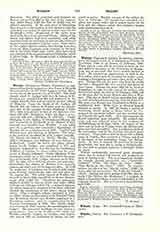

Werden (WERTHINA, WERDA, WERDENA), a suppressed Benedictine monastery near Essen in Rhenish Prussia, founded in 799 by St. Ludger, its first abbot, on the site of the present city of Werden. The little church which St. Ludger built here in honor of St. Stephen was completed in 804 and dedicated by St. Ludger himself, who had meanwhile become Bishop of Munster. Upon the death of St. Ludger, March 26, 809, the abbacy of Werden went by inheritance first to his younger brother Hildigrim I (809-827), then successively to four of his nephews: Gerfried (827-839), Thiadgrim (ruled less than a year), Altfried (839-848), Hildigrim II (849-887). Under Hildigrim I, also Bishop of Chalons-sur-Marne, the new monastery of Helmstadt in the Diocese of Halberstadt was founded from Werden. It was ruled over by a provost, and remained a dependency of Werden till its secularization in 1803. Gerfried and Altfried were also bishops of Munster. The latter is the author of the oldest life of St. Ludger (Acta SS., III, March, 641-650; P.L., XCIX, 769-90). The Abbots Thiadgrim and Hildigrim II were bishops of Halberstadt. Under the latter, the abbey church, begun by St. Ludger, was completed in 875, and solemnly dedicated to Our Savior by Archbishop Willibert of Cologne, to whose archdiocese the monastery of Werden belonged. Under Hildigrim II the monastery, which up to that time had been the property of the family of St. Ludger, obtained on May 22, 877, the right of free abbatial election and immunity. Henceforth the abbots of Werden were imperial princes and had a seat in the imperial diets. In 1130 the monastery of Liesborn was recruited with monks from Werden, replacing the nuns who had given up the regular life. The abbey church of Werden, destroyed by fire in 1256, was rebuilt in the late Romanesque style (1256-75). Thereafter the monastery began to decline to such an extent that under Abbot Conrad von Gleichen (1454-74), a married layman, the whole community consisted of but three, who had divided the possessions of the abbey among themselves. After a complete reform, instituted in 1477, by Abbot Adam von Eschweiler of the Bursfeld Union (see The Abbey of Bursfeld), Werden continued in a flourishing condition until its secularization by the Prussian Government in 1802. The church, which was restored in 1852, contains the sarcophagus of St. Ludger. The monastery buildings are now used as a penitentiary. Two of the 74 abbots who ruled over Werden, namely, Ludger, its founder, and Bardo, who died in 1051 as Archbishop of Mainz, are honored as saints. Werden was one of the richest abbeys in Germany. Its jurisdiction extended. Over about five square miles and it owned nearly all the land and the villages within that territory, besides some possessions beyond it.
MICHAEL OTT

